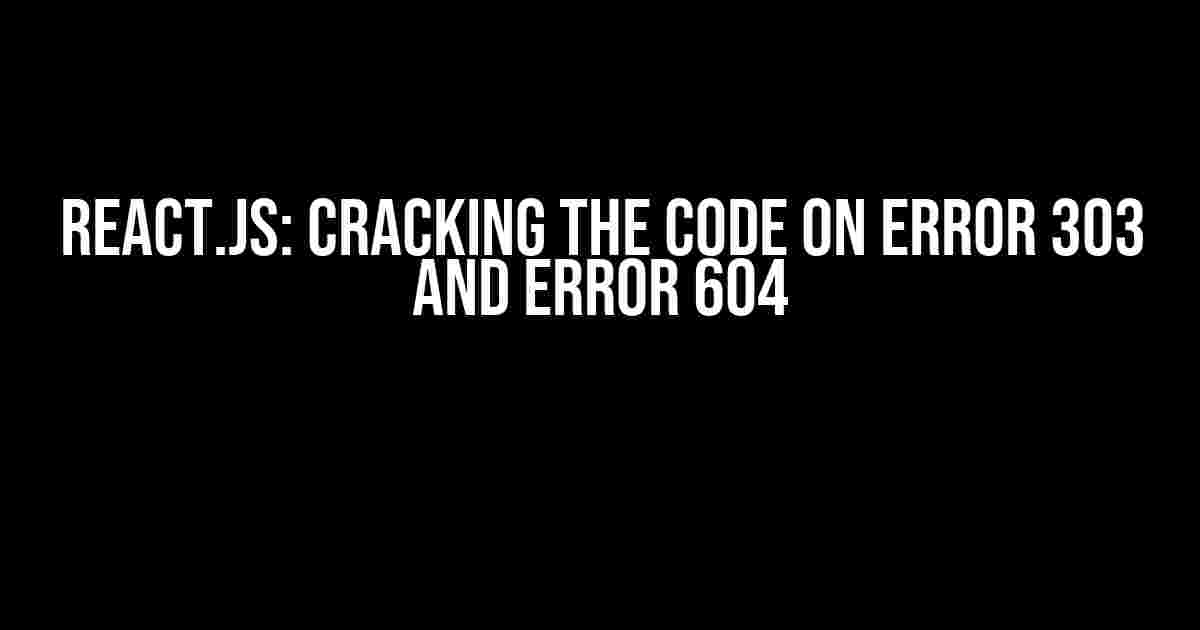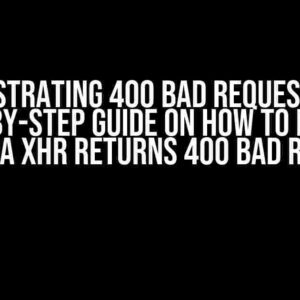Hello, fellow React enthusiasts! Are you tired of running into error 303 and error 604 while building your dream application? You’re not alone! In this article, we’ll dive into the world of React.js and explore the most common causes of these pesky errors. By the end of this journey, you’ll be equipped with the knowledge to tackle these issues head-on and get back to coding like a pro!
What are error 303 and error 604?
Error 303: See Other
Error 303 is an HTTP status code that indicates the server is redirecting the client to a different URL. In the context of React.js, this error often occurs when there’s an issue with routing or when the server is trying to redirect the user to a different page. Think of it like a detour sign on the internet highway – the server is saying, “Hey, buddy, you need to take a different route to get to your destination!”
Error 604: Gateway Timeout
Error 604, on the other hand, indicates that the gateway (or proxy server) has timed out while trying to receive a response from the upstream server. In React.js, this error can occur when there’s an issue with your API calls, server-side rendering, or even caching. Imagine it like a traffic jam on the internet highway – the gateway is stuck, and your request is stuck in limbo!
Common Causes of Error 303 and Error 604
Now that we’ve got a better understanding of these errors, let’s explore some common causes that might be driving you crazy:
Routing Issues
One of the most common causes of error 303 is routing issues. This can happen when:
- You have duplicate routes in your React Router configuration
- Your route paths are not correctly defined
- You’re using the wrong Route component (e.g.,
<Route>instead of<Route exact>)
Server-Side Rendering (SSR) Issues
Error 604 can often be attributed to SSR issues, such as:
- Incorrect server-side rendering configuration
- Failing to handle server-side errors properly
- Incompatible versions of React and React DOM
API Call Issues
Error 604 can also occur when there are issues with your API calls, such as:
- Incorrect API endpoint URLs
- Failing to handle API errors and edge cases
- Rate limiting or API key issues
Caching Issues
Caching can be a culprit behind error 604, especially when:
- You’re using an expired or invalid cache key
- Your cache configuration is incorrect
- You’re not updating your cache properly
Troubleshooting Error 303 and Error 604
Now that we’ve covered the common causes, let’s get down to business and troubleshoot these pesky errors!
Step 1: Check Your Routing Configuration
Review your React Router configuration to ensure:
- Routes are correctly defined and don’t have duplicates
- Route paths are correctly defined and formatted
- You’re using the correct Route component (e.g.,
<Route exact>)
Step 2: Verify Server-Side Rendering Configuration
Double-check your SSR configuration to ensure:
- You have the correct versions of React and React DOM installed
- Your server-side rendering configuration is correct
- You’re handling server-side errors properly
Step 3: Inspect API Calls and Caching
- API endpoint URLs are correct and correctly formatted
- You’re handling API errors and edge cases properly
- Your caching configuration is correct and up-to-date
- You’re updating your cache properly
Step 4: Check Server Logs and Network Requests
Inspect your server logs and network requests to:
- Identify any server-side errors or exceptions
- Verify that API calls are being made correctly
- Check for any caching issues or expired cache keys
Solutions and Workarounds
Now that we’ve troubleshooted the errors, let’s explore some solutions and workarounds:
Solution 1: Update React Router Configuration
import { BrowserRouter, Route, Switch } from 'react-router-dom';
const App = () => {
return (
<BrowserRouter>
<Switch>
<Route exact path="/" component={HomePage} />
<Route path="/about" component={AboutPage} />
</Switch>
</BrowserRouter>
);
};
Solution 2: Implement Proper Server-Side Rendering
import ReactDOMServer from 'react-dom/server';
import App from './App';
const serverRender = async (req, res) => {
const html = ReactDOMServer.renderToString(<App />);
res.send(`<html><body>${html}</body></html>`);
};
serverRender(req, res);
Solution 3: Handle API Errors and Caching Issues
import axios from 'axios';
const apiCall = async () => {
try {
const response = await axios.get('https://api.example.com/data');
// Handle successful response
} catch (error) {
// Handle API errors and edge cases
console.error(error);
}
};
apiCall();
Conclusion
And that’s it, folks! Error 303 and error 604 don’t stand a chance against your newfound knowledge and troubleshooting skills. Remember to stay calm, inspect your code, and follow the steps outlined in this article to conquer these pesky errors. Happy coding, and see you in the next React adventure!
| Error Code | Description | Solution |
|---|---|---|
| 303 | See Other | Check routing configuration, server-side rendering, and API calls |
| 604 | Gateway Timeout | Verify server-side rendering configuration, API calls, and caching |
Feel free to share your experiences and tips in the comments below! What’s the most frustrating error you’ve encountered in React.js, and how did you overcome it?
Frequently Asked Question
Stuck with those pesky error codes in React.js? Don’t worry, we’ve got you covered! Here are some answers to get you back on track:
Q: Why do I keep getting Error 303 in React.js?
Error 303 usually occurs when there’s a misconfiguration in your server or routing setup. Check if you’re using the correct port number, and ensure that your server is properly configured. Also, review your routing setup to ensure it’s correct. You can try resetting your server or re-configuring your routes to resolve this issue.
Q: Is Error 604 related to React.js or my server?
Error 604 is actually an issue with your server, not React.js. It’s often caused by a conflict between your server and the React app. Try checking your server logs to identify the root cause of the problem. It might be related to a misconfiguration, a plugin issue, or a conflict with another server-side technology.
Q: How do I debug Error 303 in React.js?
To debug Error 303, start by checking your browser’s console for any error messages. If that doesn’t reveal the issue, try using the React DevTools to inspect your component tree and identify any potential problems. You can also try setting breakpoints in your code to see where the error is occurring. And don’t forget to review your server logs for any clues!
Q: Can I fixed Error 604 by upgrading my React version?
Upgrading your React version might not necessarily fix Error 604, as it’s primarily a server-side issue. Instead, focus on resolving the underlying server issue that’s causing the error. If you’ve recently upgraded your React version and started experiencing Error 604, try reverting to the previous version to rule out any compatibility issues.
Q: What’s the best way to prevent Error 303 and Error 604 in React.js?
To prevent these errors, make sure your server and routing setup are properly configured. Regularly review your server logs to catch any potential issues early on. Keep your React version and dependencies up-to-date, and ensure that your code is well-organized and easily debuggable. By following these best practices, you can minimize the likelihood of encountering Error 303 and Error 604.





